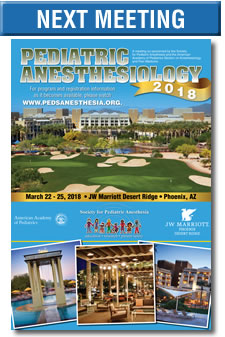Meeting Reviews
SPA Session V: “Back to the Future: A ‘Long’ Time Ago”
By Constance L. Monitto, MD
Johns Hopkins Hospital
The final session of the meeting, “Back to the Future: A ‘Long’ Time Ago” included a fascinating historical talk by Mark A. Rockoff, MD (Boston Children’s Hospital) who was introduced to the audience by his former fellow, Dr. Franklyn Cladis. Appropriately, given our membership and this year’s meeting location, Dr. Rockoff’s talk was titled “Uncovering History: The Fascinating Story of Boston’s First Pediatric Anesthesiologist” and focused on both the history of anesthesia and Dr. Freeman Allen, a forgotten pioneer in our field.
Dr. Rockoff’s talk had its roots in two paintings. The first commemorated the first public demonstration of ether by Thomas Morton. Dr. Rockoff reminded the audience that anesthesia was originally under the control of surgeons, but since they were more interested in performing surgery they often had their students anesthetize their patients. One such student was Harvey Cushing. During his first case, Dr. Cushing’s patient aspirated and died. While this was not an uncommon experience at the time, it affected him deeply and may have played a role in the contributions he made to the field of anesthesiology, including the first anesthetic record and blood pressure monitoring.
The second painting that sparked Dr. Rockoff’s interest was a portrait of Dr. Allen. However, he did not discover Dr. Allen’s role in our field until he attended an Anesthesia History Association tour of Harriet Beecher Stowe’s home. There, he discovered that Dr. Allen was her first grandchild. Researching his subject more, Dr. Rockoff learned that Dr. Allen’s mother passed away at a young age as the result of a chronic pain-related morphine addiction. He found out that Dr. Allen grew up in Boston but as a young man traveled to Europe, where he was exposed to the field of medicine. Upon returning to Boston he attended Harvard Medical School and subsequently practiced with Dr. Walter Reed in Cuba during the Spanish Civil War. In the early 1900s he traveled to New York to learn about anesthesia by working with Dr. Thomas Bennett, who invented the Bennet inhaler to provide chloroform for mothers in labor.
After returning to Boston he became the first physician to provide anesthesia at multiple hospitals in Boston, including Boston Children’s Hospital, Massachusetts General Hospital and the Boston Free Hospital for Women. Dr. Allen published a number of papers including a description of 100% N2O anesthesia and was an early advocate for the anesthetist deciding on the type of anesthesia. In addition, because most doctors wanted to be surgeons, he was instrumental in training nurses to deliver anesthesia. One of those nurses was Betty Lank, who provided anesthesia (with cyclopropane, a cut-down IV and a blood pressure cuff) when Dr. Robert Gross performed the first PDA ligation in 1938. Ms. Lank was also instrumental in training Dr. Robert Smith, a man considered by many to be the father of pediatric anesthesiology.
Dr. Allen was an avid equestrian and skier, and in 1917 traveled with Dr. William Ladd and other Boston volunteers to help provide care after the Halifax explosion. He married Mary Ethel Gibson late in life, a bond that tied him to the first painting Dr. Rockoff discussed as Miss Gibson’s grandfather was Dr. John Collins Warren, who performed the first surgery under anesthesia in the Ether Dome. Dr. Allen committed suicide in his 50s while under treatment for morphine addiction. Sadly, this malady affected not only Dr. Allen, but other illustrious physicians of his day, and continues to take a tragic toll on society today.






